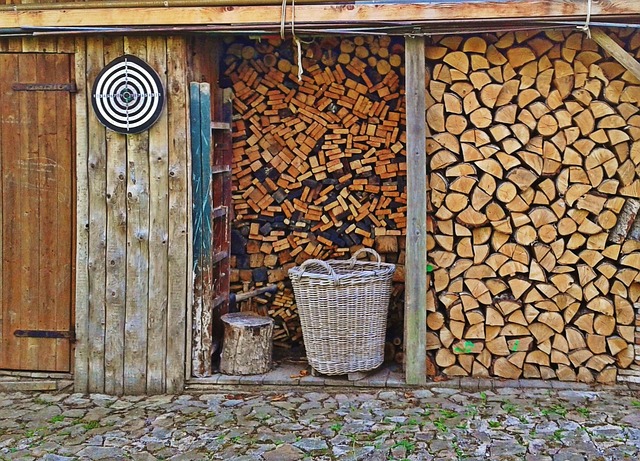Properly storing and stacking firewood is essential for ensuring a warm and cozy atmosphere during chilly nights or providing a reliable fuel source for wood-burning stoves and fireplaces. However, the process can be more challenging than it initially seems. Factors like moisture, pests, and airflow can significantly impact the quality and usability of firewood. To help you overcome these obstacles and make the most of your firewood, I wrote this article”The Ultimate Guide to Storing and Stack Firewood: Expert Tips for Keeping it Dry and Ready to Burn.”
In this comprehensive guide, I will delve into the best practices for firewood storage and stacking. Whether you have limited space in your backyard, a garage waiting to be optimized, or need solutions for outdoor storage, I have you covered. From selecting the ideal location to choosing the appropriate stacking methods, this guide will equip you with the knowledge and techniques to preserve the integrity of your firewood.
Throughout this guide, I will address common concerns and considerations, such as how to keep firewood dry, how to promote optimal drying for seasoned logs, and how to protect firewood from the elements. I will explore various storage options, such as racks, shelters, and sheds, and discuss the benefits and drawbacks of each approach. Additionally, I will cover techniques for stacking firewood to maximize space utilization and improve airflow, ensuring your wood is ready for a cozy fire whenever you need it.
Let’s get to it!
Storing Firewood Outdoors
When it comes to storing firewood outdoors, proper considerations and techniques are crucial to keep your supply dry, accessible, and in good condition. Here are some essential tips for storing firewood outdoors:
Choosing the Ideal Location
Selecting the right location for your outdoor firewood storage is the first step toward ensuring its longevity and accessibility. Consider the following factors:
- Proximity: Choose a location that is convenient and easily accessible from your house or the area where you plan to burn the firewood. This will save you time and effort when transporting the logs.
- Safety: Keep the firewood storage area at a safe distance from structures, such as your house, sheds, or trees. Aim for a minimum clearance of 5 feet to reduce the risk of fire spreading.
- Drainage: Ensure that the chosen spot has good natural drainage or install a gravel base to prevent water accumulation around the stored firewood. Excess moisture can lead to mold, rot, and make the wood difficult to ignite.
Creating a Suitable Firewood Storage Area
To protect the firewood from direct exposure to the elements and promote airflow, consider the following options for creating a suitable storage area:
- Raised Platform: Elevate the firewood off the ground by using pallets, concrete blocks, or a dedicated firewood rack. This helps prevent moisture absorption from the soil and reduces the likelihood of pests infiltrating the woodpile.
- Sturdy Rack or Shed: Construct a well-built and ventilated firewood rack or shed to shield the wood from rain, snow, and excessive sun exposure. A rack with open sides allows for better airflow, aiding in the drying process.
- Roof or Tarp Cover: If a dedicated shed is not feasible, consider installing a roof or using a waterproof tarp to provide overhead protection for the firewood stack. Ensure the cover extends beyond the dimensions of the pile to safeguard it from water seepage.
Ensuring Proper Airflow and Ventilation
Adequate airflow and ventilation are essential for preventing moisture buildup and promoting drying. Follow these guidelines:
- Spacing between Logs: Leave enough space between the stacked logs to facilitate air circulation. Avoid tightly packing the firewood, as it restricts airflow and can lead to moisture retention.
- Slatted Rack or Stacking Method: Consider using a rack with slatted sides or a stacking method that allows air to circulate around the logs. This improves ventilation and reduces the chances of mold or fungal growth.
Covering Techniques to Keep Firewood Dry
Covering your firewood stack is crucial to protect it from rain, snow, and excessive moisture. Here are some effective covering techniques:
- Waterproof Tarp or Firewood Cover: Use a durable and waterproof tarp specifically designed for firewood or a purpose-built firewood cover. Ensure the cover is large enough to completely shield the stack and extend beyond its dimensions.
- Secure Fastening: Properly secure the cover to prevent it from being dislodged by wind or animals. Use bungee cords, ropes, or straps to tightly fasten the cover, ensuring it remains in place even during inclement weather.
Regularly inspect your outdoor firewood storage area to identify any signs of moisture, pest infestation, or damage. Make adjustments as needed, such as repositioning the stack or replacing the cover, to maintain optimal conditions for your firewood. With these techniques, you can ensure that your outdoor firewood remains dry, accessible, and ready for cozy fires whenever you need them.
Stacking Firewood for Optimal Drying
Properly stacking firewood is essential to facilitate optimal drying, ensuring that your logs are ready for efficient and clean burning. Follow these guidelines to maximize the drying process:
Understanding the Importance of Drying Firewood
- Moisture Content: Green or freshly cut wood typically contains a high moisture content, making it difficult to burn efficiently. Drying, or seasoning, allows the wood to lose excess moisture, resulting in better heat output and reduced smoke.
- Faster Ignition: Well-dried firewood ignites more easily and produces a hotter and more consistent flame. Properly seasoned wood significantly reduces the risk of smoldering or excessive smoke generation.
Selecting the Right Stacking Method for Drying
- Face Cord or Row: Arrange the firewood in a single row, known as a face cord, to allow for optimal airflow and consistent drying. Ensure that the logs are aligned parallel to one another with consistent gaps between each piece.
- Crisscross or Interlocking Stacks: Create crisscross or interlocking patterns by alternating the direction of the logs with each layer. This technique promotes better stability and airflow throughout the woodpile.
Arranging Logs for Optimal Airflow and Moisture Evaporation
- Base Layer: Start by laying a solid foundation layer of logs, preferably larger or thicker pieces, to provide stability and prevent direct contact between the wood and the ground.
- Orientation: Stack the logs with their cut ends facing upward. This allows for better airflow and moisture evaporation from the ends of the logs.
- Consistent Gaps: Maintain consistent gaps between the logs, usually around 1-2 inches, to ensure adequate airflow. Avoid tightly packing the wood, as it can impede drying and lead to moisture retention.
Utilizing Spacers or Stacking Aids to Improve Drying Efficiency
- Spacers: Place small pieces of wood or wooden dowels between the logs to create gaps and improve airflow. These spacers aid in drying by allowing air to circulate freely around the logs.
- Log Racks or Stacking Frames: Consider using log racks or stacking frames designed to promote optimal airflow and drying. These structures elevate the firewood, prevent direct ground contact, and enhance ventilation.
Regularly monitor the moisture content of the firewood by using a moisture meter. Wood is considered well-seasoned when its moisture content is below 20%. Depending on the wood species and environmental conditions, drying times may vary from several months to a year or longer.
Remember to store the stack in a well-ventilated area, protect it from excessive moisture, and periodically rotate the logs to maintain even drying throughout the pile.
Storing Firewood Indoors
Storing firewood indoors offers convenience and easy access during colder months. To ensure the firewood remains in good condition and ready for use, follow these guidelines for indoor storage:
1. Assessing Indoor Storage Options
- Garage or Utility Room: If available, the garage or a utility room can serve as suitable locations for indoor firewood storage. Ensure there is sufficient space and proper ventilation to prevent moisture buildup.
- Basement or Crawlspace: Basements or crawlspaces are commonly used for firewood storage. However, assess the humidity levels and ventilation in these areas to prevent mold growth or moisture-related issues.
2. Preparing the Indoor Storage Area
- Clear and Clean Space: Clear the designated area of any debris or flammable materials to minimize fire hazards. Clean the space thoroughly to remove dust, pests, or mold that may affect the firewood.
- Provide Adequate Airflow: Ensure proper airflow in the storage area by keeping vents open or using fans to prevent moisture accumulation. Good ventilation helps maintain the quality of the firewood.
3. Using Racks, Crates, or Containers for Organization
- Firewood Rack: Invest in a sturdy indoor firewood rack that keeps the logs off the ground and promotes airflow. Choose a rack that suits the available space and can accommodate the desired amount of firewood.
- Crates or Containers: Alternatively, use crates or containers with slatted sides or ventilation holes to stack the firewood neatly. This allows for airflow while containing any potential debris or bark.
4. Addressing Moisture and Pest Control Indoors
- Moisture Control: Maintain a dry environment by monitoring and controlling indoor humidity levels. Consider using a dehumidifier if necessary to prevent excess moisture that can lead to mold or rot.
- Pest Prevention: Inspect firewood regularly for signs of pests before bringing it indoors. Treat any infested wood or store it separately to prevent the spread of pests. Use pest deterrents, such as natural repellents or stored product insects (SPI) traps, to protect the stored firewood.
Remember to periodically check the stored firewood for any signs of mold, pests, or excessive moisture. Remove any damaged or compromised logs promptly to prevent spreading issues to the rest of the supply.
Best Practices for Firewood Storage and Stacking
Implementing best practices for firewood storage and stacking is essential to maintain the quality, accessibility, and efficiency of your wood supply. Follow these guidelines to optimize your firewood storage and stacking methods:
1. Choosing the Right Firewood Size and Length
- Cut and Split to Appropriate Size: Ensure that the firewood is cut and split into manageable sizes, typically 16 to 18 inches in length. This allows for easier handling, stacking, and burning.
- Consistent Thickness: Aim for uniform thickness across the logs to promote even drying and burning. Avoid excessively thick pieces that take longer to season and ignite.
2. Properly Seasoning Firewood for Efficient Burning
- Allow Sufficient Drying Time: Season firewood by allowing it to dry for a minimum of six months, but preferably one to two years. Properly seasoned wood has lower moisture content, leading to cleaner combustion and higher heat output.
- Stacking in a Well-Ventilated Area: Stack the firewood in a location that provides good airflow and ventilation to facilitate drying. Outdoor racks, sheds, or well-ventilated storage areas are ideal for the seasoning process.
3. Maintaining a Rotation System for Older and Newer Logs
- First-In, First-Out (FIFO): Implement a rotation system where older, seasoned firewood is used first, while newer logs are stored for further drying. This ensures that the woodpile remains well-seasoned and ready for use.
- Proper Organization: Keep the firewood stack organized by clearly separating older and newer logs. This allows for easy identification and access to the wood that is ready for burning.
4. Stacking Firewood to Optimize Space Utilization
- Stable and Tightly Stacked: Create stable and tightly stacked woodpiles to optimize space utilization. Avoid leaning or unstable stacks that may pose safety hazards.
- Alternating Directions: Alternate the direction of logs with each layer to enhance stability and promote airflow. This helps in proper seasoning and drying of the firewood.
5. Safety Precautions and Considerations
- Fire Safety: Store firewood away from heat sources, such as stoves or fireplaces, to reduce the risk of accidental ignition. Keep a safe distance to prevent sparks or embers from reaching the woodpile.
- Pest Control: Regularly inspect the firewood stack for signs of pests. Treat any infestations promptly and take preventive measures to protect your stored firewood.
Remember to always handle firewood with care, wear appropriate protective gear such as gloves, and use proper lifting techniques to avoid injury.
Regular maintenance and adherence to these guidelines will help you maintain a reliable and high-quality wood supply for a warm and inviting fire.
Additional Tips and Tricks
In addition to the best practices for firewood storage and stacking, consider implementing the following tips and tricks to enhance your firewood management:
Storing Kindling and Smaller Wood Pieces
- Separate Storage Container: Use a separate container or bin to store kindling and smaller wood pieces. This ensures easy access and prevents them from getting lost within the larger firewood stack.
- Dry and Covered Storage: Keep the kindling and smaller wood in a dry and covered area to maintain their readiness for starting fires.
Utilizing Pallets for Elevated Storage
- Elevated Platform: Place pallets or wooden boards on the ground to create an elevated platform for storing firewood. This helps prevent moisture absorption from the soil and improves airflow.
- Stack on Pallets: Stack the firewood directly on the pallets, allowing for better ventilation and protection from ground moisture.
Using Tarps, Covers, or Waterproofing Methods
- Additional Waterproofing: If storing firewood outdoors, consider using additional waterproofing methods. For example, place a layer of plastic sheeting beneath the firewood stack to prevent ground moisture from seeping in.
- Ventilated Covers: Use covers specifically designed for firewood storage that provide protection from rain while allowing for proper ventilation. Ensure the covers are properly secured to withstand wind and weather conditions.
Proper Maintenance and Inspection Routines
- Regular Inspection: Routinely inspect your firewood stack for signs of decay, mold, or pest infestations. Remove any compromised logs promptly to prevent further damage.
- Maintenance and Reorganization: Periodically reorganize the firewood stack, ensuring proper airflow and stability. This also allows you to assess the condition of the wood and make necessary adjustments.
Seasoned Logs for Immediate Use
- Reserve Seasoned Logs: Keep a reserve of well-seasoned firewood indoors for immediate use. This ensures you have readily available wood that is properly dried and ready to burn.
- Indoor Storage Considerations: Follow the guidelines for indoor firewood storage (as outlined in Section IV) to maintain the quality and accessibility of the seasoned logs.
Conclusion
In conclusion, when it comes to storing firewood, the best way is to prioritize three key factors: keeping it dry, ensuring proper airflow, and protecting it from pests. By following the best practices outlined in this guide, such as choosing an ideal location, using well-ventilated storage solutions, and covering the wood appropriately, you can maintain the quality and efficiency of your firewood supply.
Remember to regularly inspect and maintain your storage area to address any issues promptly. With the knowledge and techniques gained from this guide, you can confidently store your firewood and enjoy cozy fires whenever you desire. Stay warm and make the most of your firewood!
Next Read: What Can You Burn In A Fire Pit Other Than Wood? Fire Pit Fuel Beyond Wood





